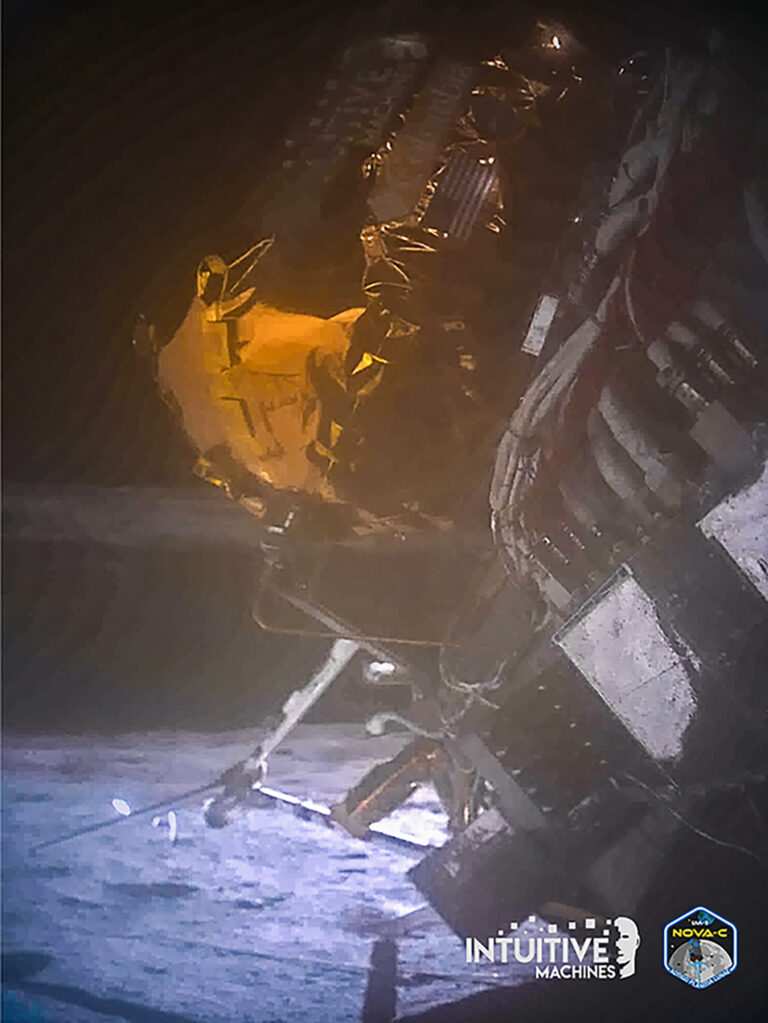
Nearly six days after making history by becoming the first commercial company to successfully land on the moon, Intuitive Machines released the first images of its lander on the surface.
The images show the moments during touchdown of the Houston-based company’s Nova-C lander Odysseus — nicknamed “Odie” — as it skidded across a crater near the moon’s south pole, and its final resting spot not in an upright position, but not entirely on its side either.
“Here we are. Our Odie conducted the brilliant six-day mission on the surface,” said company CEO Steve Altemus during a press conference with NASA officials. “You see that we were tilted over slightly, still more upright than we initially thought. We did land upright, we captured data, and then we tilted over slowly.”
The image taken Feb. 27 several days after landing by the lander’s narrow-field-of-view camera was the first successful shot of it on the surface post-landing after previous images had unusable data, and helped illustrate the angle to which it finally came to rest.
Two other images taken Feb. 22 showed the damaged landing gear as it made its way across the surface during touchdown.
“This is a picture of Odie on the surface of the moon touching down with its engine firing,” Altemus said. “The landing gear pieces broken off there on the left of the image. The landing gear did what it was supposed to do and protect the lander as it landed on the surface.”
He noted the imagery showed how the lander interacted with the lunar regolith and what sort of plume the lander created.
“There’s scientific information in that data right there,” he said. “What you don’t see in this picture, is that we landed — our navigation system landed us with precision and landed us softly on the moon. Shock absorbers took the load and the lander now tilted over gently.”
Because of the angle, which Altemus said is likely at around 30 degrees tilt, the solar power panels were not able to get as much power over the last week, and that some of the landers’ antenna were not delivering data at the expected rate. Those were the reasons mission managers decided to focus on getting as much data outputted as possible, which shortened the mission’s hopeful lifespan by a few days.
Altemus said the company expects the lander to have complete loss of power Wednesday night. The six NASA and six private payloads on board are not designed to endure the cold lunar night, but Intuitive Machines will try and reboot Odysseus in a few weeks once it’s back in the sunlight to see if teams on Earth can still communicate with it.
The mission, which launched from Florida’s Kennedy Space Center atop a SpaceX Falcon 9 rocket on Feb. 15, was the second private lunar launch as part of NASA’s Commercial Lunar Lander Payloads program. The first, from Pittsburgh-based Astrobotic in January, ended with its lander suffering a propellant leak soon after launch that led to that company eventually bringing it back to burn up on re-entry into Earth’s atmosphere.
The Intuitive Machines mission marked the first U.S.-based lunar mission to successfully make a soft landing since Apollo 17’s landing in 1972.
NASA paid Intuitive Machines $118 million with the goal of building the lander, procuring a launch provider, and taking care of all the communications during the mission. In turn, NASA handed the company its six payloads worth about $12 million, while Intuitive Machines lined up the other six payloads.
“Bottom line is that every payload has met some level of their objectives,” said NASA’s Sue Lederer, a CLPS project scientist. “We’re very excited to start poring through the data.”
One of the private payloads was a set of cameras built by Embry-Riddle Aeronautical University students and faculty called EagleCam, named after the school’s mascot. It was originally tasked to be deployed before landing and try and take a photo of the lander as it made its final descent, but teams opted to hold off that deployment to focus on solving problems during landing.
Altemus said EagleCam was powered up again Wednesday morning, and they were able to eject it about 13 feet away.
“However, either in the camera, or in the Wi-Fi signal back to the lander, something might not be working correctly,” Altemus said. “So the Embry-Riddle team is working on that and wrestling with that to see if there’s anything they could do.”
Altemus said he’d like to give EagleCam another shot on a future mission.
Intuitive Machines has two more of what is so far seven additional NASA CLPS missions already under contract with the next expected before the end of the year.
“Before the mission, we had an absolute sense of humility, yet relied on our technical excellence and trusted years of experience and this incredible team that we have,” Altemus said. “Following this — I would say — unqualified success of a mission. I’m emboldened.”
___
© 2024 Orlando Sentinel
Distributed by Tribune Content Agency, LLC.
0 comments :
Post a Comment